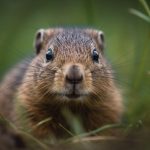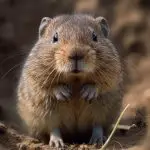How to Find Gopher Holes? – Everything You Need To Know
Seeing a damaged lawn, crop field, or garden caused by pesky gophers is always frustrating. To control these pests, identifying gopher holes is crucial. Gophers are burrowing rodents. They create a network of underground tunnels to live in and secretly reach out to the plants.
You can identify gopher holes by noticing their created soil mounds, using a soil probing method, closely observing their surface movement, etc.
Nevertheless, locating gopher holes is important for controlling these backyard pests. It is because it allows for the targeted placement of traps, baits, or other control methods.
Additionally, knowing the gopher hole location of the burrows can help with prevention efforts by allowing for the placement of deterrents. Also it will allow you to install barriers to restrict the gophers from entering an area in the first place. Most importantly, it restricts harming non-targeted animals.
To provide you with an in-depth understanding of the these backyard pests hole-finding process, we discuss all the respective aspects here. Let’s dive deeper.
Identifying Gopher Holes
Well, gophers are not the only hole-makers out there. The holes can be made by other rodents, small animals, and even your pets. So, without ensuring that the holes are made by gophers, the population control actions will harm those animals.

Here, we elaborate on the process of gopher hole identification.
Types of Gopher Holes
To identify gopher holes, you must understand that gophers create tunnels not only to go here and there. The gopher tunnel system is actually their home, just like our houses. These tunnels also have various parts, which we can categorize into different types of holes.

Soil Mounds
Gophers create soil mounds on the surface as they dig their tunnels. These mounds are typically about 6 to 8 inches in diameter and can be several inches high.
The mounds are usually crescent-shaped, but you can also see some shoe-shaped mounds. Such shaping is basically formed when gophers turn around to go back into the hole after pushing the soil out of the tunnel.
Burrow Openings
These are the primary entrance and exit points of the underground tunnel system. The openings with the main tunnel are generally used by gophers to reach the surface area.
The main burrow openings are usually located at the center of the gopher’s territory. However, there are also some other types of burrow openings that serve different purposes, like holes for fresh air plugs, etc.
Main Runway
The main runway or tunnel is actually the connection between the vertical passages with burrow openings and the lateral tunnels. In general, gophers create the main tunnel parallel to the ground surface, below 6 to 18 inches.
Lateral Tunnels
These tunnels are the branches of the main tunnel. These lead to feeding chambers and nesting areas. Lateral tunnels are typically smaller than the main tunnel and do not have any openings with the outer environement.
Designated Areas
As mentioned, the tunnel system is the home for gophers. Every tunnel system is equipped with food storage areas, resting areas, etc. These are connected to the main tunnel through the lateral tunnel and are usually located 6 feet below the surface.
Tips for Identifying Gopher Holes
Identifying gopher holes can be a challenging task. To assist in the identification, here are some tips that you can use to determine gophers’ presence:

- Hole size: Gopher pits are typically about 2-4 inches in diameter. People often become confused while differentiating gopher holes and mole holes. Keep in mind that mole dugouts are usually larger and can be up to 6 inches in diameter.
- The shape of the holes: Gopher holes are often crescent-shaped, with a raised lip of soil on one side of the opening. However, shoe-shaped gopher soil pits are also commonly visible.
- Holes’ locations: Gopher pits are often found in areas where soil types include well-watered and vegetation-rich characteristics. They used to build the tunnel system in vegetation-rich areas; equipped with easy-to-tunnel soft soils.
- Soil mounds: If there is any gopher presence, surely there are soil mounds. You can easily identify those by examining the respective soils’ thick crust and porous composition.
- Activity: If you sense that gophers are present within the vegetation area, spend some time examining their activity. By observing their physical movements, you will be able to locate their main tunnel system along with the openings.
Differential Factors in Holes Made by Various Rodents
The below table contains the most common deterrent characteristics within the borings made by different rodents.
| Differential criteria | Gopher holes | Mole holes | Ground squirrel holes |
| Hole diameter | 2-4 inches | 6 inches | 1-2 inches |
| Shape | Crescent-shaped | Circular | Similar to gopher potholes, the soil around the hole is often more loosely packed. |
| Location | Near vegetation or in areas with well-watered soil | Grassy areas or areas with loose soil | Near rocks, fences, or walls |
Locating Gopher Holes
In the above section, we learned how to identify gopher shafts for backyard maintenance. Here, we are going to explore the process of locating gopher soil pits.

Tips for Locating Gopher Holes
If you suspect gophers in your area, use the tips below to be assured of their presence.
- Check soil state: First, check the soil’s criteria. Gophers always prefer burrowing in loose, well-drained soils such as sandy or loamy soils. They avoid heavy clay soils, as those are difficult to dig through.
- The moisture level of soil: Second, check the moisture of the soil. If the area is waterlogged, there is no chance that gophers are present. They like moist soils that are not waterlogged.
Also, to be sure, you can check the area’s water level. Gophers prefer areas with high water tables as those areas are generally vegetation-rich.
- Vegetation areas are highly susceptible: If the area is equipped with dense vegetation of all kinds, there’s a high chance that gophers are nearby.
- Check for gophers’ activity: Spend multiple mornings or afternoons spotting gophers physically. Gophers are highly active during these times and can roam around on the surface to search for food.
Techniques for Finding Gopher Holes
To find gopher shafts, there are three most popular techniques; visual inspection, probing the soil, and releasing water into the tunnel system. Let’s check them one by one.

Visual Inspection
It is the easiest technique to find gopher dugouts. This method involves looking for crescent-shaped soil mounds or fresh dirt around vegetation. The pests often leave piles of soil near the entrance to their burrows, making it easier to spot their soil pits.
Probing the Soil
We suggest you use this method only if you have seen several soil mounds or gophers physically. The reason is that application of this method can partially damage the area. It is not good if you have a high-profile lawn or garden with expensive grass.
However, in this method, you need to insert a long, thin rod or stick into the ground to locate gopher tunnels. By probing the soil, you can feel the presence of tunnels and determine the direction they are heading.
Please note that even though this method is more effective than the visual inspection method, it is still time-consuming and requires some skill.
Watering Method
This method involves flooding a gopher tunnel with water and observing where the water comes out. If you see that the poured water is coming out of another hole, it is a confirmation that gophers are present.
This method is effective, but it can be messy and requires a lot of water.
Using Other Signs to Locate Gopher Holes
We already know that gophers are naturally driven to damage the soil surface and vegetation within the area where they are active. And the damage-related activities always contain some signs.
You can use those to pinpoint the location of gopher soil pits. Here’s how to do that:
- Check out soil mounds that are crescent- or shoe-shaped and 2 inches in diameter.
- If there are fresh soils around the base of the plant, you can suspect that gophers are active below the plant.
- Look for plants that are wilted, yellowing, or have been completely pulled out of the ground. This is a crucial sign that gophers are active in the area.
- When you go for lawn care, check the ground. If surfaces in some places have raised ridges or depressions, surely gophers’ tunnels went through there.
- Gophers are active during the day. If you put some concentrations in, you will be able to hear them moving around underground.
Preventing Gopher Damage
After finding the gopher dugouts, it is time to take preventive actions to protect the vegetation. Before we dig towards the preventive methods, it is essential to understand the contribution of gopher hole identification and controlling approaches to the pest prevention process.

Importance of Gopher Holes Identification and Controlling
Here’s why it’s crucial to identify gopher holes;
- It restricts harming non-target animals while ensuring the survival of small animals that have been designated as protected.
- The number of dugouts provides an idea about the size of the respective gopher population. It assists in selecting the right and effective gopher species control method.
- By locating and controlling gopher potholes, you can prevent gophers from accessing a particular area, as you know where gophers are present.
- Gopher control is important to prevent damage to your lawns, gardens, and crops.
- Finally, gopher hole identification and control allow you to maintain a safe environment while following the government’s direction in gopher population control.
Gopher Control Methods
Below is a list of the most common and legal gopher control methods.
- Trapping: Use specialized traps near the gopher ditchs to catch the gopher. You should know that this method is not very effective if the gopher population is huge. However, you must follow the associated trapping regulations to protect other small animals and birds.
- Barriers: Exclusion is another suitable method to control the gopher population. It involves using physical barriers such as fencing or mesh to prevent gophers from accessing an area. However, it is a time-consuming approach.
- Lethal Action: The use of poisonous baits at gopher boreholes is also an effective prevention measure. Still, it can kill non-target animals and should only be used as a last resort.
- Using Repellents: Put substances that repel gophers, such as castor oil, garlic, peppermint oil, etc. Also, you can go for vegetation that gophers do not like. Plant crown imperials, lavender, rosemary, salvia, catmint, etc., within the surrounding gopher shafts.
- Professional Help: Take assistance from pest control companies.
- Wildlife Management: Go for consultation with wildlife management associations and organizations.
FAQs
Below are the answers to some of the most relevant questions about gophers’ hole identification.
Can Gophers Have More Than One Hole?
Yes, as per the gopher’s behavior, they can have multiple potholes in their tunnel system. Apart from multiple exits and entry dugouts, they also create pits for other purposes. One most common purposes is for fresh air plugging in.
How Deep Can Gopher Burrows Go?
The depth of gopher burrows depends on the soil type and other environmental factors. In general, gopher’s animal behavior directs gophers to go as deep as 6 feet (1.8 meters) underground.
Final Words
Identifying and locating gopher shafts is essential for effective pest control. Finding gopher pits will greatly assist you in selecting the best control method to use.
You will be able to apply the right control method based on the specific situation while ensuring safety for people, pets, protected animals, and overall wildlife.
However, the fresh soil mounds, vegetation gopher damage or disruption, and the appearance of gopher tunnels, etc., are signs of gophers’ presence. These signs are crucially helpful in your gopher hole-finding process.
Additionally, you can easily identify their shafts by having a deeper understanding of gopher behavior and characteristics. Once gopher potholes are located, appropriate control measures such as trapping, baiting, exclusion, or repellents can be used to prevent gopher damage.
Lastly, after coming across how to find gopher holes, eventually, people tend to go for mass control, which should be restricted. Advanced study and research on the ecological impacts of gophers on ecosystems will help to restrict this.
Here, finding the gopher wells and controlling those can be helpful as an alternative to mass control, a critical barrier considering deadly wildlife removal.




